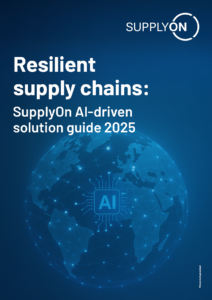The 5 building blocks to deliver the ROI of your digital transformation
![[virtual image with 5 cubes highlighted in orange] To ensure your digital transformation initiative delivers the desired results and promised ROI, you need a strategic approach covering 5 steps](https://cdn.supplyon.com/wp-content/uploads/2023/11/5-building-blocks-ROI-digital-transformation_Blog_1200x627px.jpg)
In the dynamic business landscape, digital transformation has emerged as a game-changer. As organizations try hard to stay competitive and relevant, it’s no longer a question of if but how and when they should embark on their digital transformation journey. However, achieving a return on investment (ROI) from these efforts is not a given; it requires a strategic approach. Here is a brief summary, after 14 years in the industry, of the five building blocks to consider when embarking on a digital transformation initiative to ensure and deliver the ROI you expect.
1. The right scope
One of the fundamental drivers of digital transformation ROI is defining the right scope. Without a clear understanding of what needs to be transformed and why, your efforts can become unfocused and wasteful. Start by identifying specific pain points, goals, and the expected outcomes. This will allow you to prioritize and allocate resources effectively, ensuring that your digital transformation initiatives align with your business objectives, and most importantly, it allows you to track where the ROI is coming from.
2. When the decision is made:
go all in!
Digital transformation isn’t just about embarking on the journey; it’s about ensuring you reach the destination successfully. One critical driver of digital transformation ROI is completing the transformation and fully digitizing the processes.
When a project remains incomplete or certain processes aren’t fully digitized, companies often find themselves in a challenging situation. They end up managing both the old, legacy systems and the newly digitized processes simultaneously. This not only leads to operational inefficiencies, but also dilutes the potential ROI.
To maximize your digital transformation ROI, it’s crucial to ensure that the transformation journey is comprehensive and delivers on the defined scope. This will not only streamline operations, but also allow your organization to fully leverage the benefits of digital technology, ultimately delivering the desired return on investment.
3. If you don’t get started, you’ll move backwards: pilots as a means to test, learn and capitalize
Digital transformation doesn’t have to be an all-or-nothing endeavor. A successful approach often involves starting with pilot projects. These smaller initiatives provide a testing ground for new technologies and processes, allowing you to test your assumptions, learn, and capitalize, before scaling up. Pilots also demonstrate the benefits of digital transformation to stakeholders, building trust and buy-in across the entire organization.
4. Change management: bringing new solutions into usage
Successful digital transformation is as much about managing people as it is about implementing technology. Change management is a critical driver of ROI because it ensures that your workforce is equipped to adapt to the new digital environment. Effective communication, training, and support mechanisms help employees to make a smooth transition and become advocates for the change rather than resistors.
5. Managing the change: bridging the old and the new
While change management sets the stage, ongoing management of the change is essential and requires a delicate balancing act. Digital transformation is not a one-time event, but an ongoing process. It’s not just about defining the new processes post-digitization, but also about handling the past activities that were managed with the old processes.
This includes defining the new processes, managing the legacy processes/non-digital methods, continuously monitoring the transition, and ensuring that value is delivered, even after the digitization project is finished.
By successfully managing the change and bridging the gap between old and new processes, your organization can make the most of its digital transformation efforts and achieve a higher ROI, even when dealing with legacy activities. This holistic approach ensures that no stone is left unturned on your journey toward a more efficient and digitally empowered future.
In conclusion, delivering ROI through digital transformation is attainable, but it demands a strategic and comprehensive approach. It starts with defining the right scope, gaining full commitment, and initiating pilots to validate your efforts. Effective change management ensures that your workforce is aligned with the transformation, and ongoing management keeps your initiatives on the path to success. By embracing these five drivers, your organization can not only navigate the challenges of digital transformation but also reap the rewards of a more efficient, competitive, and innovative future.




